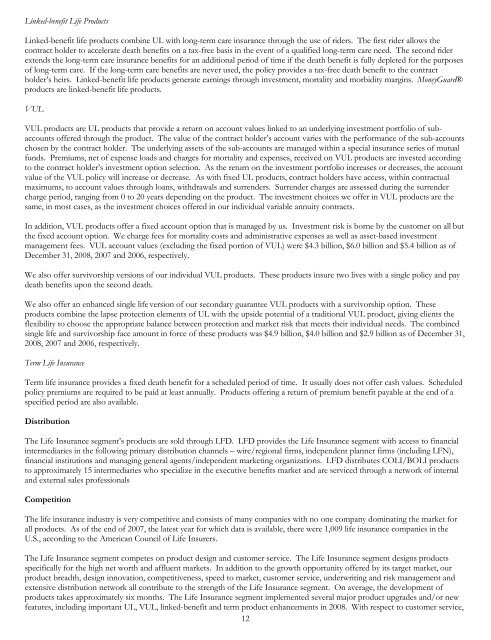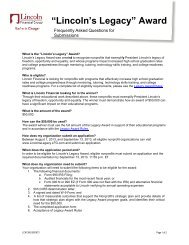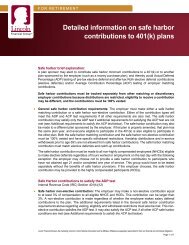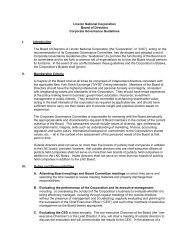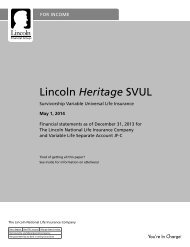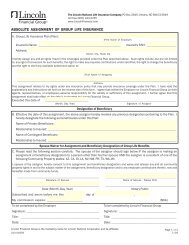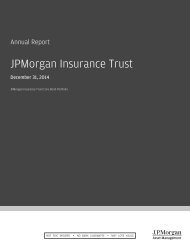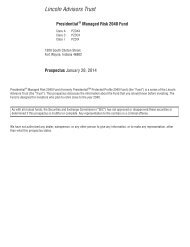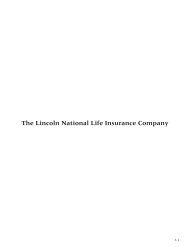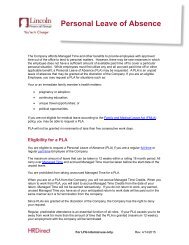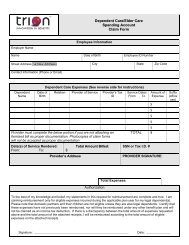2008 Annual Report to Shareholders - Lincoln Financial Group
2008 Annual Report to Shareholders - Lincoln Financial Group
2008 Annual Report to Shareholders - Lincoln Financial Group
Create successful ePaper yourself
Turn your PDF publications into a flip-book with our unique Google optimized e-Paper software.
Linked-benefit Life Products<br />
Linked-benefit life products combine UL with long-term care insurance through the use of riders. The first rider allows the<br />
contract holder <strong>to</strong> accelerate death benefits on a tax-free basis in the event of a qualified long-term care need. The second rider<br />
extends the long-term care insurance benefits for an additional period of time if the death benefit is fully depleted for the purposes<br />
of long-term care. If the long-term care benefits are never used, the policy provides a tax-free death benefit <strong>to</strong> the contract<br />
holder’s heirs. Linked-benefit life products generate earnings through investment, mortality and morbidity margins. MoneyGuard®<br />
products are linked-benefit life products.<br />
VUL<br />
VUL products are UL products that provide a return on account values linked <strong>to</strong> an underlying investment portfolio of subaccounts<br />
offered through the product. The value of the contract holder’s account varies with the performance of the sub-accounts<br />
chosen by the contract holder. The underlying assets of the sub-accounts are managed within a special insurance series of mutual<br />
funds. Premiums, net of expense loads and charges for mortality and expenses, received on VUL products are invested according<br />
<strong>to</strong> the contract holder’s investment option selection. As the return on the investment portfolio increases or decreases, the account<br />
value of the VUL policy will increase or decrease. As with fixed UL products, contract holders have access, within contractual<br />
maximums, <strong>to</strong> account values through loans, withdrawals and surrenders. Surrender charges are assessed during the surrender<br />
charge period, ranging from 0 <strong>to</strong> 20 years depending on the product. The investment choices we offer in VUL products are the<br />
same, in most cases, as the investment choices offered in our individual variable annuity contracts.<br />
In addition, VUL products offer a fixed account option that is managed by us. Investment risk is borne by the cus<strong>to</strong>mer on all but<br />
the fixed account option. We charge fees for mortality costs and administrative expenses as well as asset-based investment<br />
management fees. VUL account values (excluding the fixed portion of VUL) were $4.3 billion, $6.0 billion and $5.4 billion as of<br />
December 31, <strong>2008</strong>, 2007 and 2006, respectively.<br />
We also offer survivorship versions of our individual VUL products. These products insure two lives with a single policy and pay<br />
death benefits upon the second death.<br />
We also offer an enhanced single life version of our secondary guarantee VUL products with a survivorship option. These<br />
products combine the lapse protection elements of UL with the upside potential of a traditional VUL product, giving clients the<br />
flexibility <strong>to</strong> choose the appropriate balance between protection and market risk that meets their individual needs. The combined<br />
single life and survivorship face amount in force of these products was $4.9 billion, $4.0 billion and $2.9 billion as of December 31,<br />
<strong>2008</strong>, 2007 and 2006, respectively.<br />
Term Life Insurance<br />
Term life insurance provides a fixed death benefit for a scheduled period of time. It usually does not offer cash values. Scheduled<br />
policy premiums are required <strong>to</strong> be paid at least annually. Products offering a return of premium benefit payable at the end of a<br />
specified period are also available.<br />
Distribution<br />
The Life Insurance segment’s products are sold through LFD. LFD provides the Life Insurance segment with access <strong>to</strong> financial<br />
intermediaries in the following primary distribution channels – wire/regional firms, independent planner firms (including LFN),<br />
financial institutions and managing general agents/independent marketing organizations. LFD distributes COLI/BOLI products<br />
<strong>to</strong> approximately 15 intermediaries who specialize in the executive benefits market and are serviced through a network of internal<br />
and external sales professionals<br />
Competition<br />
The life insurance industry is very competitive and consists of many companies with no one company dominating the market for<br />
all products. As of the end of 2007, the latest year for which data is available, there were 1,009 life insurance companies in the<br />
U.S., according <strong>to</strong> the American Council of Life Insurers.<br />
The Life Insurance segment competes on product design and cus<strong>to</strong>mer service. The Life Insurance segment designs products<br />
specifically for the high net worth and affluent markets. In addition <strong>to</strong> the growth opportunity offered by its target market, our<br />
product breadth, design innovation, competitiveness, speed <strong>to</strong> market, cus<strong>to</strong>mer service, underwriting and risk management and<br />
extensive distribution network all contribute <strong>to</strong> the strength of the Life Insurance segment. On average, the development of<br />
products takes approximately six months. The Life Insurance segment implemented several major product upgrades and/or new<br />
features, including important UL, VUL, linked-benefit and term product enhancements in <strong>2008</strong>. With respect <strong>to</strong> cus<strong>to</strong>mer service,<br />
12


